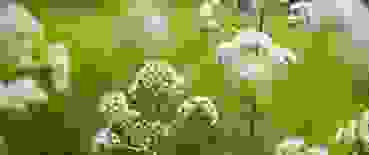
Valerian (Valeriana officinalis)
Falling asleep quickly and sleeping well through the night - not everyone finds this easy: valerian root is used to treat mild nervous tension and sleep disorders.
Valerian (Valeriana officinalis L.) is well known to many people as a medicinal plant with sleep-inducing effects. But valerian has also proved its worth for use in cases of nervousness or restlessness - often in combination with other medicinal plants. This is why valerian is one of the most widely used herbal sedatives today. Read more about the occurrence, appearance, history, effect and use of the valerian plant in this article.
Occurrence and distribution of valerian
Valerian is a plant species of the valerian genus (Valeriana) and belongs to the honeysuckle family (Caprifoliaceae). The Valeriana genus includes a total of more than 300 different species of valerian. They are widespread in the northern hemisphere in Asia, Europe, North America and are also found in South America. Many of these species grow at higher altitudes. Some of them are also found in mountainous regions, for example in the Andes.
Valerian (sometimes also called “true valerian” or “large valerian” in German) is often used for medicines. It grows wild in large parts of Europe and is widespread eastwards as far as China, Korea and Japan. The plant is also native to Switzerland, especially in higher but warmer regions. It often grows in meadows near streams, rivers or lakes.
If you have a suitable, sunny and moist location in your garden, some Valeriana species can also be planted as decoration, to attract bees or as a medicinal plant.
Appearance of valerian
True valerian grows up to two metres tall. It is a hardy perennial that survives the winter through its underground rhizomes. A tall stem bears large, pinnate leaves. Flowers form in umbels in spring from May to June. The many small individual flowers can be white to pink in colour. The unusual strong, sweetish scent of the flowers is very noticeable.
After flowering, the plant produces small nut-like seeds (achenes) that can spread in the wind with the aid of an umbrella-like tuft of fluff. Valeriana officinalis also tolerates flooding which even encourages dispersal, as the seeds float and can easily adhere to other surfaces when wet. Plants with this type of propagation are also called aquatics.
History and tradition of valerian
The typical valerian smell develops when the root is dried. Humans find this rather unpleasant. However, it is just as attractive to cats as the well-known catnip. It therefore merits its common names of “cat's-weed” and “stinkwort”. In old legends it is even reported that the Pied Piper of Hamelin carried valerian with him to attract the rats. Valerian extracts are also used in perfume production. When used in tiny quantities, they lend a slightly musky note to perfume blends. The ingredient isovaleric acid is responsible for the strong scent which can be attractive or repulsive depending on the species. Incidentally, unpleasant foot odour is also due to this substance, among other things. Certain bacteria form isovaleric acid from the leucine found in sweat.
The intense smell is also the reason why Nordic people once hung the valerian plant over the front door as protection against evil spirits. If you carried a piece of the plant with you, it was supposed to protect you from witches and the devil. The name “witchweed”, which is still used locally, harks back to this custom. According to tradition, if a bunch of valerian hung in the room moved, it indicated that an invisible spirit or a witch had entered the room.
Valerian root has been used in folk medicine for many centuries. Even in the “old days”, its beneficial effect as a relaxant and sedative was known. Valerian was often administered together with lemon balm or hops, as it is today.
Ingredients and effect of valerian
Only the valerian root (Valerianae radix) is used medicinally. It contains a number of unusual ingredients. These include essential oils and valepotriates from which isovaleric acid mentioned earlier in this article is derived, as well as other substances. The essential oil of the root contains ingredients such as borneol, camphor and beta-bisabolene.
Valerian calms and has a sleep-inducing effect. Lignans as well as essential oils could be responsible for this. These substances apparently have a similar effect on the central nervous system as the body's own substance adenosine which forms part of the system that influences the sleep-wake rhythm. Among other effects, it binds to so-called A1 receptors and thus induces drowsiness and sleep. Lignans derived from valerian root act on the same receptors. However, other ingredients of valerian may also play a part.
Valerian as a medicine
This is general information. For individual advice, please contact a specialist.
Valerian preparations are among the most commonly used herbal sedatives. Extracts from the valerian root are frequently used today for sleep disorders. But they are also known to have an effect against nervousness or feelings of restlessness or unease.
Valerian for difficulty in falling asleep
Around one third of all adults and also more and more school children suffer from sleep problems. A first step in treatment should always be behavioural therapy, such as improving sleep hygiene. But herbal medicines can also help with sleep problems. Valerian preparations relax and promote falling and staying asleep as well as improve the quality of sleep. Traditionally, preparations made from a combination of valerian and hops are often used for this purpose.
Valerian root for tension or restlessness
Taking valerian extract has a calming effect on people suffering from nervousness, tension and restlessness. Stress and nervousness are reduced. Preparations combining valerian with various medicinal plants such as hops, lavender, lemon balm and passion flower are also suitable in such cases.
Modern herbal medicine
Modern herbal medicine (phytotherapy) combines centuries-old knowledge with the latest scientific findings.
DetailsModern herbal medicine
Modern herbal medicine (phytotherapy) combines centuries-old knowledge with the latest scientific findings.
Details

